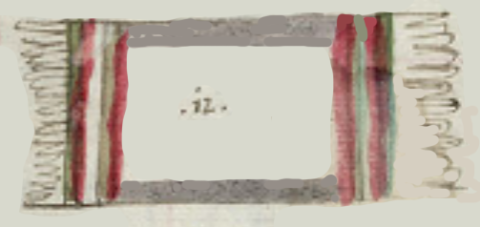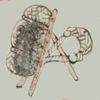ichcatilmatli (CST35)
This painting of the simplex glyph for the term ichcatilmatli (wool blanket) shows a horizontal, rectangular, striped blanket with a fringe at both ends. The bulk of the blanket is white, and the stripes are gray, red, and green. The companion text explains that twelve of these blankets were required for the local hospital. This was a time of raging epidemic disease, which probably made the provisioning of the hospital essential.
Stephanie Wood
The tilmatli can be a blanket, as it is here, although it is usually a cape worn by Indigenous men of high status. Kevin Terraciano refers to the blankets here as being of cotton, which could be an alternative translation for ichcatl, but the codex has much to say about sheep and stock raising in these pages, which may suggest that the blankets would be made of wool. See Terraciano’s study (Codex Sierra, 2021), page 122 (for the Nahuatl transcription of the relevant passage) and page 156 (for the English translation).
Stephanie Wood
1550–1564
Jeff Haskett-Wood
cobijas, lana, algodón, hospitales, enfermedades, epidemias

ichaca(tl), unspun wool or cotton, https://nahuatl.wired-humanities.org/content/ichcatl
tilma(tli), a cloak or blanket, https://nahuatl.wired-humanities.org/content/tilmatli
cobija de lana
Stephanie Wood
Códice Sierra-Texupan, plate 35, page dated 1561. Origin: Santa Catalina Texupan, Mixteca Alta, State of Oaxaca. Kevin Terraciano has published an outstanding study of this manuscript (Codex Sierra, 2021), and in his book he refers to alphabetic and “pictorial” writing, not hieroglyphic writing. We are still counting some of the imagery from this source as hieroglyphic writing, but we are also including examples of “iconography” where the images verge on European style illustrations or scenes showing activities. We have this iconography category so that such images can be fruitfully compared with hieroglyphs. Hieroglyphic writing was evolving as a result of the influence of European illustrations, and even alphabetic writing impacted it.
https://bidilaf.buap.mx/objeto.xql?id=48281&busqueda=Texupan&action=search
The Biblioteca Digital Lafragua of the Biblioteca Histórica José María Lafragua in Puebla, Mexico, publishes this Códice Sierra-Texupan, 1550–1564 (62pp., 30.7 x 21.8 cm.), referring to it as being in the “Public Domain.” This image is published here under a Creative Commons license, asking that you cite the Biblioteca Digital Lafragua and this Visual Lexicon of Aztec Hieroglyphs.









